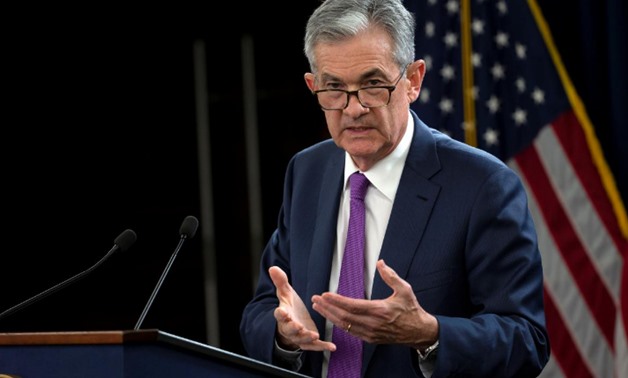
FILE PHOTO: U.S. Federal Reserve Chairman Jerome Powell holds a news conference following a two-day Federal Open Market Committee (FOMC) policy meeting in Washington, U.S., September 26, 2018. REUTERS/Al Drago/File Photo
NEW YORK - 29 November 2018: U.S. Federal Reserve Chair Jerome Powell injected investors with a strong dose of optimism on Wednesday, saying that the central bank’s policy rate is now “just below” estimates of a level that neither brakes nor boosts a healthy U.S. economy, comments that many investors read as signaling the Fed’s three-year tightening cycle is drawing to a close.
Stocks and interest-rate futures jumped, even while economists wrestled to interpret whether Powell intended to send a message or was simply misunderstood.
On their face, the comments were a reversal from early last month, when Powell said the key interest rate was probably still a “long way” from a so-called neutral level and that the Fed might even tighten policy beyond that level. Stocks swooned on those remarks as investors bet the U.S. central bank would need more rate hikes to prevent the economy from overheating.
The possibly dovish shift in language on Wednesday came as President Donald Trump stepped up attacks on Powell, criticizing the Fed’s rate hikes as undercutting his economic and trade policies. Trump told the Washington Post just on Tuesday that he is “not even a little bit happy” with the Fed chief.
Powell “gave the market, and presumably President Trump, exactly what he wanted, which was an admission that the previously proposed path of future rate hikes was probably too aggressive and opening to slowing the rate of hikes,” said Oliver Pursche, vice chairman and chief market strategist at Bruderman Asset Management in New York.
The Fed has settled into a quarterly rate-hike cycle and is still expected to raise rates again next month, in what would be the fourth hike this year. But signs of a slowdown overseas and nearly two months of market volatility - including another sharp selloff last week - have clouded an otherwise mostly rosy U.S. picture in which the economy is growing well above potential and unemployment is the lowest since the 1960s.
“We know that things often turn out to be quite different from even the most careful forecasts,” Powell said at an Economic Club of New York luncheon on Wednesday. “Our gradual pace of raising interest rates has been an exercise in balancing risks.”
Rates “are still low by historical standards, and they remain just below the broad range of estimates of the level that would be neutral for the economy,” he added.
COMMUNICATION ERROR?
Factually, Powell’s remarks on Wednesday and in October are both true. On Wednesday he referenced a range, and in October he likely referenced a median. The benchmark rate, now at 2.00-2.25 percent, is within a quarter of a percentage point of the bottom of the Fed’s range for neutral, but is also several quarter-point rate hikes below the mid-point estimate of 3 percent.
But markets, especially after the recent selloff, were focused less on such subtleties than on what Powell may have telegraphed about the future path of rate hikes.
“If there has been one certainty of late it is the market’s ability to misinterpret Fed Chairman Powell. This was again on display today,” RBC Capital Markets chief U.S. economist Tom Porcelli wrote in a note.
Although a December rate hike has been widely expected, the Fed’s path next year has been more uncertain, with investors last month expecting two or even three rate hikes in 2019.
The fed fund futures contract expiring in January 2020, a heavily traded contract that reflects market expectations for where rates will be at the end of 2019, rallied sharply on record volume and pointed to an implied yield of 2.70 percent. It was 2.95 percent earlier this month, suggesting investors have scratched off a full rate hike from their forecasts of Fed policy.
Stock markets began a broad descent toward a correction - a decline from the most recent peak of at least 10 percent - in early October, just after Powell had sounded a quite confident tone on the economy. Since then, he and other Fed officials have sounded a bit more cautious, nodding to a slowdown in Europe, Japan and China.
Just on Tuesday, Fed Vice Chair Richard Clarida, in a speech to many of the same economists and investors in New York, used precisely the same language to describe the policy rate as “just below” the range for neutral.
Neither Clarida nor Powell said definitively whether rate hikes should stop at neutral, and each stressed that level was very difficult to estimate. Fed forecasts from September showed policymakers expected to raise rates a bit above 3 percent by around 2020, according to the median.
On Wednesday Powell said the Fed is paying “very close” attention to economic data even as it expects continued “solid” growth, low unemployment and inflation near its 2 percent target.
The Fed takes equally seriously the risks of hiking too quickly and shortening the economic expansion, and on the other hand of hiking too slowly and prompting higher inflation or financial instability, Powell said.


Comments
Leave a Comment